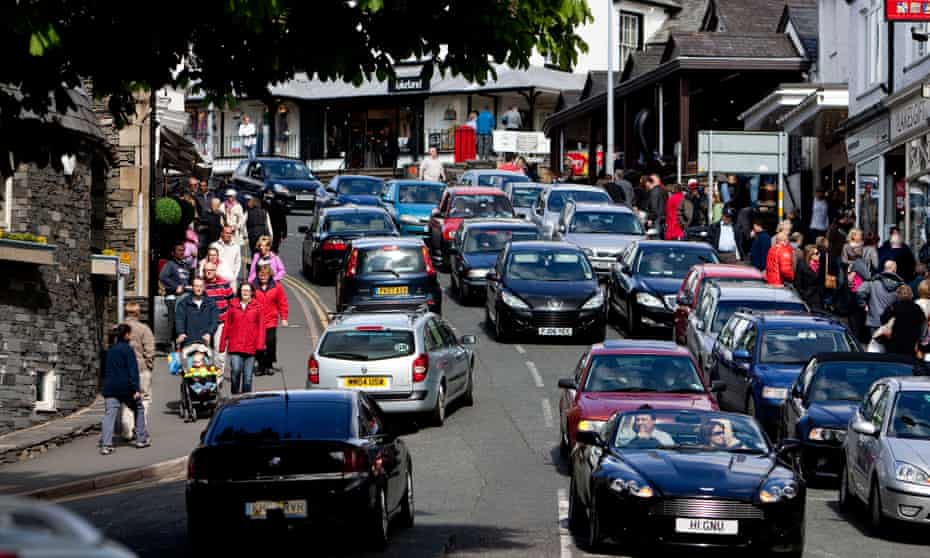Tourists’ cars may be banned from most popular parts of Lake District
National park chief wants to bring in more sustainable transport to stop worsening congestion

For most of the years he explored his beloved Lakeland fells, Alfred Wainwright arrived by bus, carefully timing his descents so he never missed the last service back to Kendal.
Thirty years after his death, more than 90% of the Lake District’s 19 million annual visitors arrive by car, seeking – perhaps ironically – the unspoiled views, clean air and stunning scenery Wainwright extolled in his Pictorial Guides.
Now, in a move that might prompt a smile from the curmudgeonly AW beyond the grave, tourist cars could be banned from some of the most popular parts of the Lake and Peak Districts next summer as they struggle with surging demand from domestic visitors.
National parks across the UK are grappling with congestion and their climate commitments. Unable to limit visitors via entrance charges, as their American counterparts do, they are looking for solutions to an increasingly unsustainable problem.
“It feels like we are at peak car,” said Richard Leafe, chief executive of the Lake District national park (LDNP). “I want to see less reliance on it into the future. It cannot go on getting worse otherwise it really will become too much to handle in our national parks. We need to see a shift to more sustainable travel.”
Last summer free shuttle buses were trialled along the Wasdale valley by Wastwater and from Cockermouth to Buttermere, a lake that has become increasingly popular because of TikTok and Instagram and which is getting “rammed with parking”, according to Leafe.
The park is now “actively considering” closing the most popular valleys to cars during peak season, said Leafe. Access would be retained for residents, buses and bikes, as well as walkers. Likely candidates include Great Langdale, which includes Wainwright favourites Bowfell and the Crinkle Crags, and Wasdale.
At the same time, the LDNP is infuriating residents by granting planning permission for ever bigger car parks in an attempt to stop “fly parking” in certain hotspots. Locals in Portinscale, near Keswick, are trying to stop a car park under consideration near Cat Bells, an easy peak where rangers discovered a mini rave after the first lockdown eased in 2020.
Dr Julie Carter is among many objectors. “It’s not just the climate and congestion issues, it is also that the lichens are dying from emissions, and the otters are washed out by the tarmac, leading to increased runoff rates, and the bats are disturbed by the lights,” she said.
In the Peak District, park bosses want to trial “hail-a-ride”, an on-demand bus service to encourage visitors to leave the car at home. “It’s Uber but on bus scale,” said Sarah Fowler, the park’s chief executive. “It’s not a scheduled bus service, but you hail it using an app, and it carries people from gateway sites in to the park.”
She has also begun discussions with the local rail companies about putting on special bike carriages to encourage more people to cycle in the park.
Fowler said she was interested to explore a proposal put forward by the Hope Valley Climate Action Group to close selected roads to cars, probably in the Ringinglow/Stanage area, freeing space for walkers and cyclists.
Making the Peak District more accessible by public and active transport is a social justice issue, the group argues. “One-third of households in Sheffield do not have a car and Manchester has one of the lowest car ownership rates in the country,” they noted in a recent report. “Reimagining travel could open up the national park to more low-income households, new arrivals to the UK and people living with impairments,” they argue.
Fowler said the car-free days were “a really interesting concept” she was keen to explore.
In Scotland, a free shuttle bus service is being piloted next year in Loch Lomond & The Trossachs national park, with park bosses considering hiking parking prices in future.
Kenny Auld, head of visitor services, said: “If you want to park your car at the bottom of a hill, that could come at a premium. And that could help subsidise other transport modes which are more inclusive,” he said.
But he stressed: “I think at the moment it’s very unfair for us to criticise any car drivers enjoying the national park because we don’t have a system that provides many choices. We’re working hard to quickly catch up and create a system that gives people choice and that’s inclusive, affordable and keeps people connected to the landscape.”
In Wales, the most popular car park at the foot of Snowdon now costs GBP25 for eight to 12 hours as part of measures to deter motorists.
A report last year into transport and parking in Snowdonia concluded that “the current over-reliance on cars to access key honeypot sites and the chronic parking problem at busy times of year is failing the national park’s core purposes.”